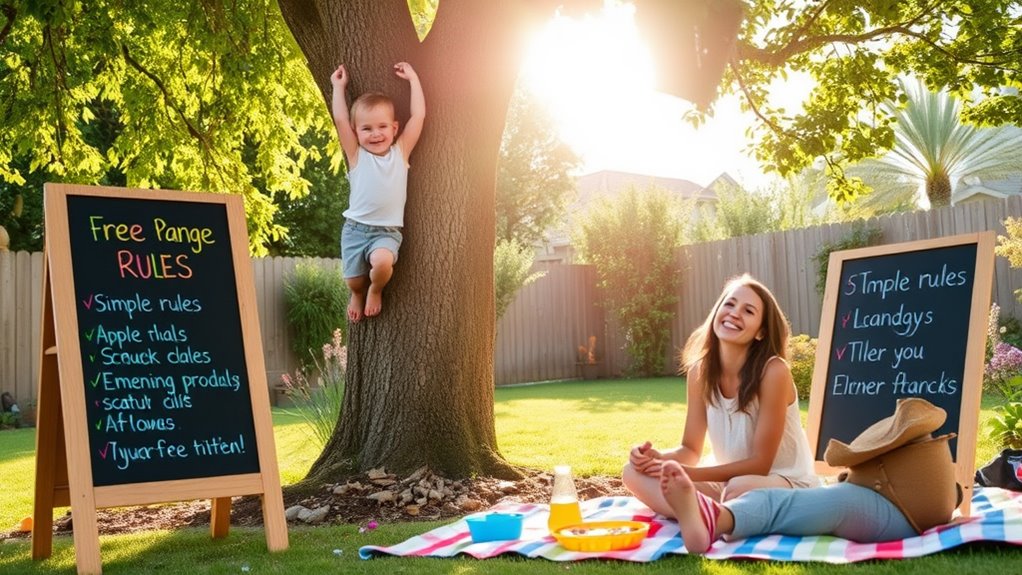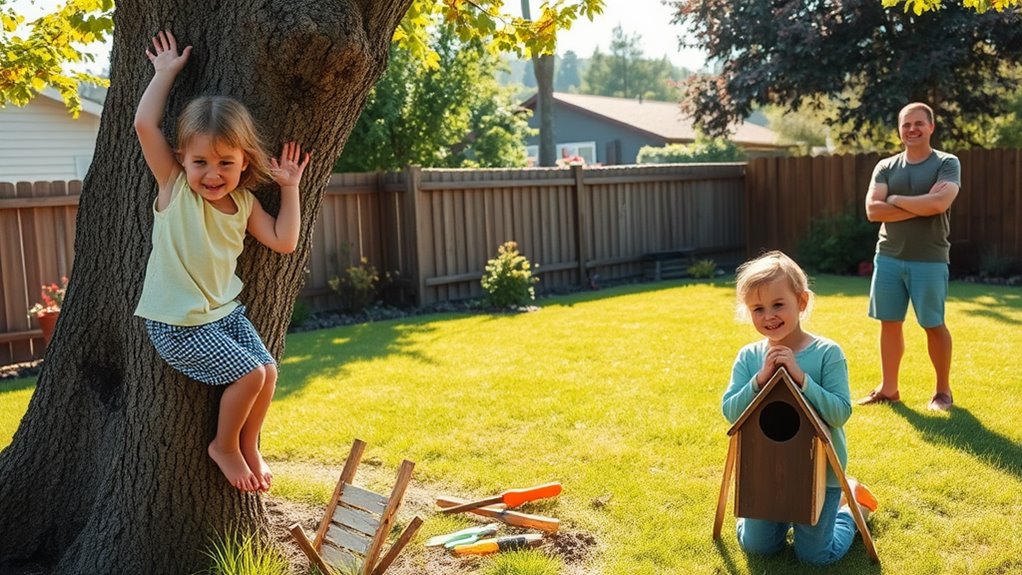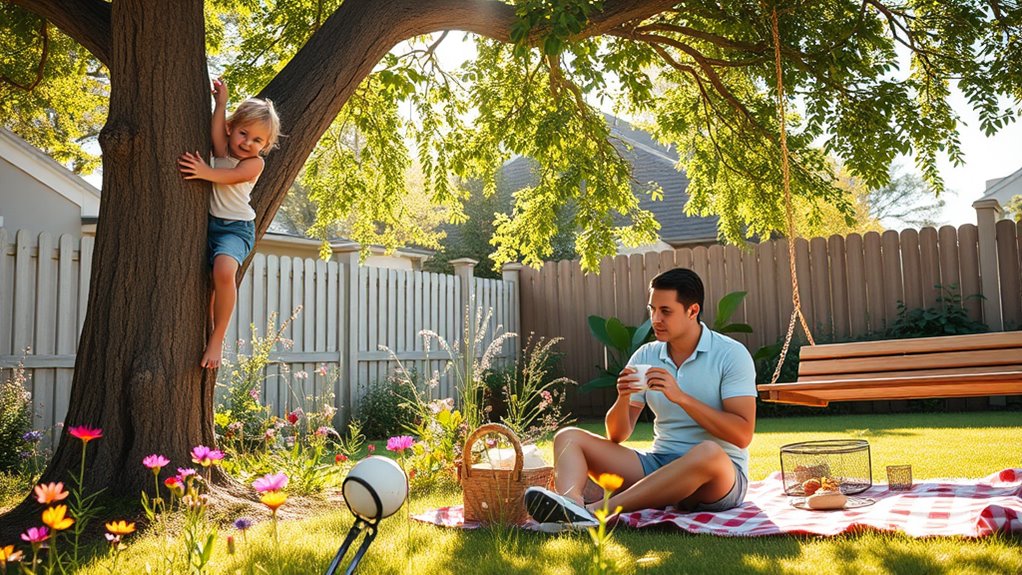How to Implement Free-Range Parenting in Your Family
To implement free-range parenting in your family, start by evaluating your child’s readiness for independence. Observe their maturity and decision-making skills. Next, set clear boundaries that emphasize safety while allowing freedom. Involve your kids in the process so they feel a sense of ownership. Encourage responsibility by assigning age-appropriate tasks and allowing them to make choices, including mistakes. Help them develop problem-solving skills through open-ended questions, and communicate safety strategies. Trust your instincts to find the right balance for your child, and you’ll foster their self-reliance and creativity. There’s plenty more to explore on this topic!
Understanding Free-Range Parenting

Understanding free-range parenting means embracing a hands-off approach that encourages children to explore their environment independently. This parenting style promotes self-reliance, allowing kids to develop problem-solving skills while learning from their experiences. Instead of hovering over your child, you give them the freedom to navigate challenges on their own, which can boost their confidence.
In free-range parenting, you trust your child to make decisions, whether it’s climbing a tree in the park or figuring out how to play with new friends. You might worry less about controlling every aspect of their playtime and focus more on fostering their curiosity and creativity. This approach helps children learn to assess risks and develop resilience, essential skills they’ll carry into adulthood.
It’s important to create a safe environment where exploration is encouraged, yet boundaries are still in place. Setting clear guidelines helps your child understand limits while allowing them the freedom to stretch those boundaries.
Assessing Your Child’s Readiness

Determining your child’s readiness for free-range parenting involves observing their behavior, maturity level, and ability to handle independence. Start by paying attention to how your child reacts in different situations. Can they make decisions and solve problems on their own? For instance, if they can navigate a conflict with a friend or choose appropriate activities during free time, that’s a great sign.
Next, consider their age and development. Younger children may need more guidance, while older kids often crave independence. Think about their ability to follow rules and understand consequences. Are they responsible enough to take care of their belongings and follow through on commitments?
It’s also vital to communicate with your child. Ask them how they feel about taking on more independence. This conversation not only helps you gauge their readiness but also builds trust between you two.
You want to guarantee they feel comfortable with the idea of exploring their surroundings without constant supervision.
Setting Boundaries and Guidelines

Setting clear boundaries and guidelines is essential for successful free-range parenting. Without these, your kids might feel lost or unsure about what’s acceptable. Start by discussing your family values and what’s important to you. This creates a foundation for the rules you’ll set together.
Make certain your children understand the reasons behind each boundary you establish. When they grasp the “why,” they’re more likely to respect the limits you’ve set.
Next, involve your kids in the boundary-setting process. Ask for their input and consider their age and maturity. This not only empowers them but also encourages them to take ownership of their actions. For instance, if you’re setting limits on screen time, let them suggest what feels fair and balanced.
Lastly, be consistent with your guidelines. Consistency helps kids know what to expect and builds trust. Remember, it’s okay to adjust boundaries as your child grows and demonstrates responsibility.
Flexibility is key, but maintaining a core set of guidelines guarantees they’ve a safe environment to explore their independence. By laying down these boundaries, you’re giving your child the freedom to grow while keeping them grounded.
Encouraging Independence and Responsibility

In a world where kids often rely heavily on adults, encouraging independence and responsibility can feel like an intimidating task. However, it’s essential for their growth and development.
Start small. Give your child age-appropriate tasks, like making their own lunch or organizing their backpack. These simple responsibilities can boost their confidence and help them learn valuable life skills.
As you introduce more independence, make sure to step back and let them make choices—even if they don’t always make the “right” ones. Mistakes are part of learning!
Encourage problem-solving by asking open-ended questions, like “What do you think you could do differently next time?” This promotes critical thinking and allows them to take ownership of their decisions.
Praise your child when they take initiative, even in small ways. Positive reinforcement goes a long way in building their self-esteem.
It’s also important to establish a routine that includes responsibilities, which can help your child understand that independence comes with accountability.
Balancing Freedom and Safety

Finding the right balance between freedom and safety can be challenging for parents embracing free-range parenting. You want to encourage your child’s independence while also ensuring they’re safe.
Start by setting clear boundaries that promote autonomy but keep them secure. For example, let your child explore the neighborhood, but establish a safe distance they can wander.
Communication is key. Talk to your kids about potential dangers and what to do if they find themselves in an uncomfortable situation. Equip them with skills like using a phone, knowing emergency numbers, and recognizing safe spaces. This way, they feel empowered while you maintain peace of mind.
Also, consider your child’s maturity level. Each child is unique, so what works for one mightn’t work for another. Trust your instincts and adjust your approach as necessary.
